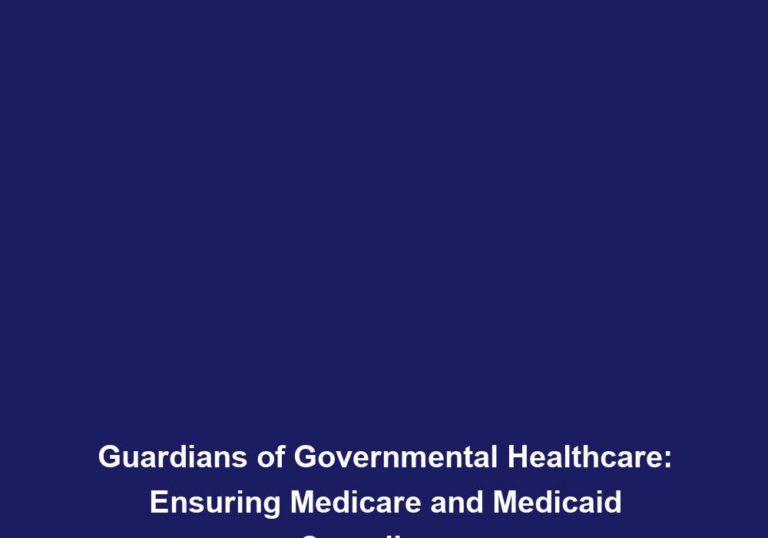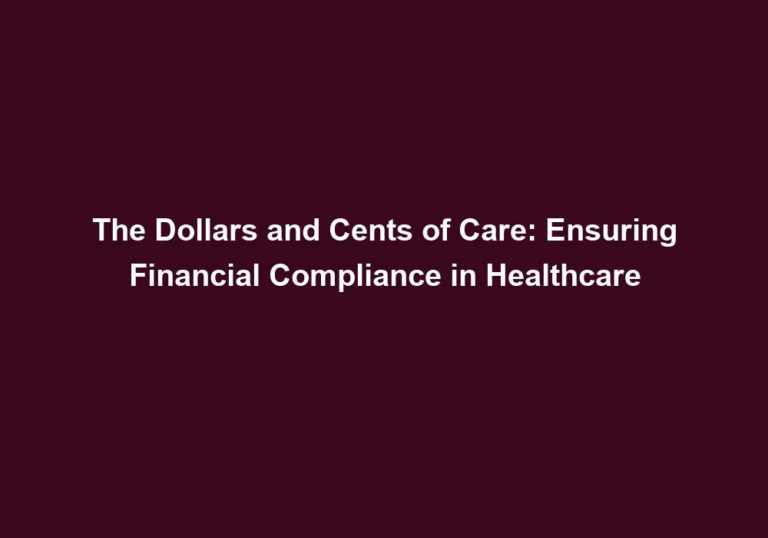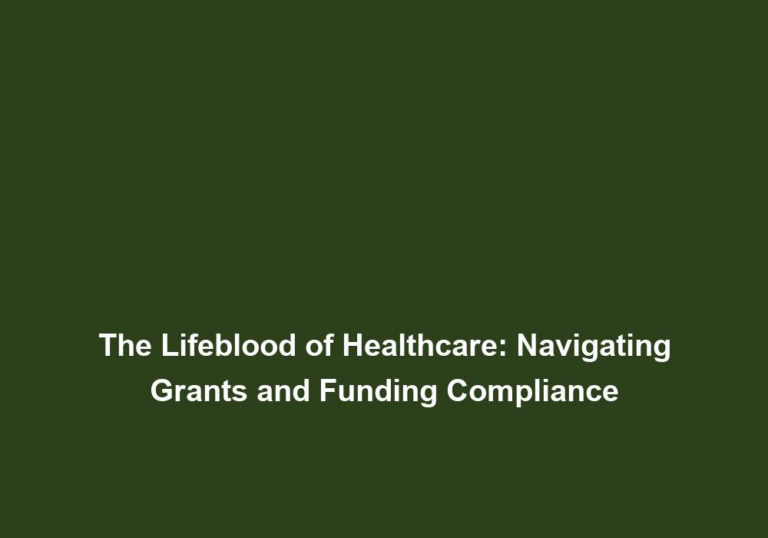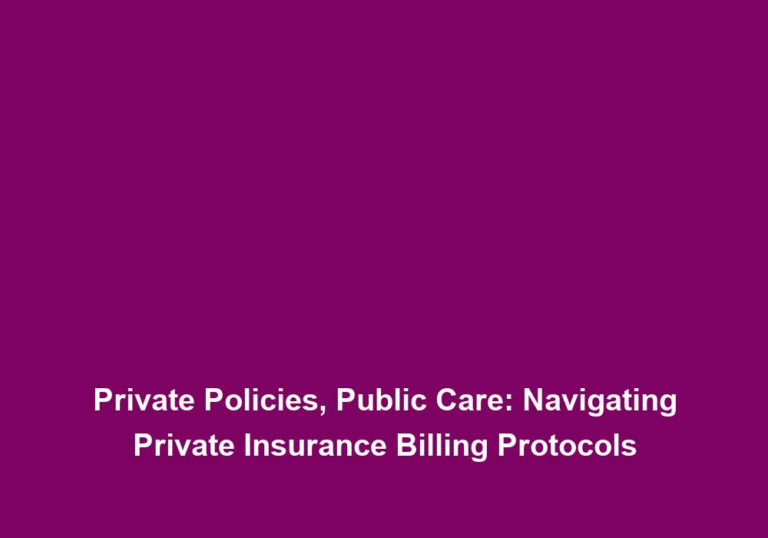The Financial Heartbeat of Healthcare: Navigating Billing and Reimbursement Regulations
In the ever-evolving landscape of healthcare, understanding and effectively navigating billing and reimbursement regulations is vital for healthcare providers and organizations. The financial wellbeing of any healthcare entity relies heavily on its ability to accurately bill and receive reimbursements for the services they provide. This article aims to shed light on the intricacies of billing and reimbursement regulations, providing valuable insights and guidance for healthcare professionals.
Importance of Billing and Reimbursement Regulations
Billing and reimbursement regulations serve as the heartbeat of financial stability in the healthcare industry. Healthcare providers must comply with a complex set of rules and regulations to ensure they are appropriately compensated for the services rendered. Failure to adhere to these regulations can result in financial losses, legal complications, and even reputational damage.
The importance of billing and reimbursement regulations cannot be overstated. They establish the framework for healthcare providers to receive timely and accurate payments for the care they deliver. Compliance with these regulations is crucial for maintaining financial stability and ensuring the ongoing provision of quality healthcare services. By understanding and adhering to these regulations, healthcare providers can safeguard their revenue streams and avoid potential penalties or legal consequences.
Understanding the Basics of Billing and Reimbursement
Billing and reimbursement involve the process of invoicing patients or insurance companies for the healthcare services provided. It is essential to have a comprehensive understanding of the key components involved.
1. Coding Systems
Coding systems, such as the Current Procedural Terminology (CPT) and International Classification of Diseases (ICD), play a crucial role in accurately documenting and billing for services. Providers must assign the appropriate codes to reflect the procedures or diagnoses involved in a patient’s treatment accurately.
Accurate coding is essential for ensuring proper reimbursement. The CPT codes represent the specific services rendered, while the ICD codes capture the diagnoses. By assigning the correct codes, healthcare providers can communicate the nature and extent of the services provided, facilitating accurate billing and reimbursement.
2. Claim Submission
Once services have been provided, healthcare providers must submit claims to insurance companies or government payers for reimbursement. This process involves compiling all relevant documentation, including patient information, coding details, and supporting documents, to ensure accurate and timely claim submission.
Claim submission requires attention to detail and adherence to specific requirements. Providers must ensure that all necessary information is included, such as patient demographics, dates of service, and supporting documentation. Timely submission is also crucial to avoid potential delays in reimbursement.
3. Reimbursement Models
Various reimbursement models exist, including fee-for-service, bundled payments, and capitation. Each model has its own set of rules and regulations that dictate how healthcare providers are reimbursed for their services. Understanding these models is crucial for maximizing revenue and maintaining financial stability.
The fee-for-service model reimburses healthcare providers based on the quantity of services rendered. Bundled payments, on the other hand, provide a single payment for an episode of care, encouraging coordination among providers. Capitation involves a fixed payment per patient, incentivizing providers to focus on preventive care. By understanding these reimbursement models, healthcare providers can adapt their billing strategies accordingly to optimize revenue.
4. Compliance with Regulatory Requirements
To ensure proper billing and reimbursement practices, healthcare providers must adhere to a variety of regulatory requirements, including the Health Insurance Portability and Accountability Act (HIPAA), the Affordable Care Act (ACA), and various state-specific regulations. Failure to comply with these regulations can lead to severe penalties and financial repercussions.
Compliance with regulatory requirements is essential for maintaining the trust and confidence of patients, as well as avoiding legal and financial risks. HIPAA, for example, governs the privacy and security of patient information, requiring healthcare providers to safeguard patient data. The ACA establishes standards for healthcare coverage and ensures access to affordable care. By complying with these regulations, healthcare providers can demonstrate their commitment to ethical and legal practices.
Challenges in Billing and Reimbursement
Navigating billing and reimbursement regulations can be a daunting task due to several challenges faced by healthcare providers. Some of the common challenges include:
1. Complex Coding Systems
Coding systems, such as CPT and ICD, are continuously updated and revised, making it essential for healthcare providers to stay up-to-date with the latest changes. Failure to accurately assign codes can result in claim denials or improper reimbursement.
Healthcare providers must invest time and effort in continuous education and training to remain abreast of coding system updates. Staying informed about new codes, revisions, and coding guidelines ensures accurate coding and minimizes the risk of claim denials or reimbursement discrepancies.
2. Insurance Claim Denials
Insurance claim denials are a significant challenge faced by healthcare providers. Denials can occur due to various reasons, including missing or incorrect information, lack of medical necessity, or failure to meet specific coverage criteria. Effectively appealing denials and ensuring proper reimbursement requires specialized knowledge and expertise.
To overcome claim denials, healthcare providers should implement robust processes for claims management. This includes thorough verification of patient insurance coverage, meticulous documentation, and proactive communication with payers to address any issues or discrepancies promptly. Additionally, developing expertise in claims appeals can help providers navigate the complex process of challenging denials and securing proper reimbursement.
3. Third-Party Payer Complexity
Dealing with multiple third-party payers, such as insurance companies and government payers, introduces complexity into the billing and reimbursement process. Each payer has its own set of rules, coverage guidelines, and reimbursement rates, making it crucial for providers to navigate these intricacies effectively.
To effectively manage the complexities of third-party payer arrangements, healthcare providers should establish clear processes and procedures for each payer. This includes understanding the specific requirements of each payer, ensuring accurate and timely submission of claims, and maintaining open lines of communication to address any issues or inquiries. Additionally, leveraging technology solutions, such as revenue cycle management software, can streamline the billing and reimbursement process and help ensure accuracy and efficiency.
4. Evolving Regulatory Landscape
Billing and reimbursement regulations are subject to constant change, driven by evolving healthcare policies and reimbursement models. Staying updated with these changes and ensuring compliance is a significant challenge for healthcare providers and organizations.
To stay ahead of the evolving regulatory landscape, healthcare providers should prioritize ongoing education and training. This includes actively participating in industry conferences, subscribing to reputable publications, and engaging with professional organizations that provide updates on regulatory changes. Additionally, establishing a dedicated compliance team or partnering with experts in revenue cycle management can help healthcare organizations navigate the complexities of changing regulatory requirements.
Strategies for Navigating Billing and Reimbursement Regulations
Effectively navigating billing and reimbursement regulations requires a proactive and strategic approach. Here are some strategies to help healthcare providers overcome the challenges and achieve financial stability:
1. Continuous Education and Training
To stay ahead of the ever-changing landscape of billing and reimbursement, healthcare professionals must invest in continuous education and training. This ensures that they are up-to-date with the latest coding guidelines, regulatory changes, and industry best practices.
Continuous education and training can take various forms, including attending seminars, webinars, or workshops, and participating in online courses or certification programs. By staying informed and knowledgeable, healthcare professionals can enhance their skills and capabilities in navigating billing and reimbursement regulations.
2. Robust Documentation and Coding
Accurate and detailed documentation is crucial for successful billing and reimbursement. Healthcare providers should implement robust documentation practices that capture all relevant information regarding patient encounters, procedures performed, and diagnoses made. Proper coding based on this documentation is essential to ensure accurate billing and reimbursement.
Robust documentation practices should include thorough and timely documentation of patient encounters, including relevant clinical information, treatment plans, and any other pertinent details. Additionally, healthcare providers should ensure accurate coding by following coding guidelines, seeking clarification when needed, and regularly auditing coding practices to identify areas for improvement.
3. Regular Audits and Compliance Checks
Regular internal audits and compliance checks help identify potential coding and billing errors, ensuring adherence to regulatory requirements. These audits help healthcare providers identify areas for improvement, mitigate compliance risks, and optimize revenue potential.
Internal audits should include a comprehensive review of billing and reimbursement processes, coding practices, and documentation accuracy. By conducting regular audits, healthcare providers can proactively identify and address any compliance issues, ensure consistent adherence to regulatory requirements, and optimize their revenue cycle performance.
4. Effective Denial Management
Establishing a robust denial management process is crucial for minimizing financial losses and maximizing revenue. Healthcare providers should analyze and address the root causes of claim denials, implement effective appeals processes, and leverage data analytics to identify patterns and trends.
Effective denial management involves proactive monitoring of claim denials, prompt identification of denial reasons, and timely appeals with supporting documentation. By analyzing denial patterns, healthcare providers can identify underlying issues and implement targeted strategies to reduce denials, improve reimbursement rates, and optimize revenue.
5. Collaborate with Revenue Cycle Management Experts
Partnering with revenue cycle management experts can provide healthcare providers with valuable support and expertise in navigating the complexities of billing and reimbursement. These experts understand the ever-changing regulations, industry trends, and best practices, enabling providers to optimize their revenue cycle and financial performance.
Revenue cycle management experts can assist healthcare providers in various ways, including comprehensive revenue cycle assessments, process improvement recommendations, staff training, and ongoing monitoring of regulatory changes. By collaborating with experts, healthcare providers can benefit from their specialized knowledge and experience, enhancing their ability to navigate billing and reimbursement regulations effectively.
Conclusion
Navigating billing and reimbursement regulations is a critical aspect of financial success in the healthcare industry. Healthcare providers and organizations must have a comprehensive understanding of the key components involved, overcome the challenges faced, and implement effective strategies to maximize revenue and maintain financial stability. By staying updated, adhering to regulatory requirements, and leveraging expert support, healthcare professionals can successfully navigate the financial heartbeat of healthcare.







